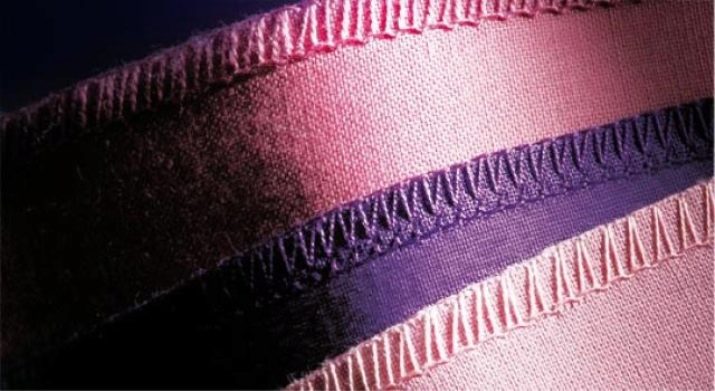All about overlock seams

Thinking about doing sewing, you should not discount the presence of an overlock, which is indispensable when processing the edges of garments. A sewing machine cannot replace special equipment that is designed for specific purposes. In this article, we will take a closer look at the main characteristics of the seams made on the overlock.

Peculiarities
Overlock - a special type of sewing equipment with the presence of two to five threads, created for high-quality processing of cuts of textile products with simultaneous trimming of the edges. As a multifunctional machine, it is also used for sewing parts together and for decoration. Overlock seams are of high quality, reliability and elasticity, which is very important when sewing knitwear.


Also, with the help of this equipment, it is possible to process sections even of very thin and crumbling tissues. The overlock machine, taking into account the options present, is capable of performing various types of seams, both classic and decorative (often at the end of the work, a special wheel is used as a decorative element for processing the edges).

Classic views
There are many different types of sewing stitches that can be easily sewn on overlock equipment. Depending on the number of threads that are involved in overcasting, such seams are of the following types: two-, three-, four- and five-thread. Next, we will consider each of the options listed in more detail.
- Double thread seam... This option is usually used on the thinnest fabrics using the minimum amount of thread.Since the presence of three or more threads is common in overlocks, you should make sure that the converter is present on a specific model. It looks like a special clip that will overlap the top element. To make a seam like this, you need one needle and a lower looper.

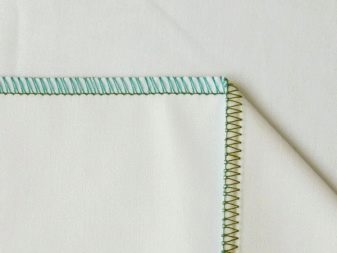
- Three-thread seam. The most common option that can be created on both older and newer hardware. This type is considered the best option for home sewing. In order to sew a seam like this, there must be one needle and two loopers (this is the lever with a thread hole) where the thread is pulled over the fabric using the top looper. From the inside of the seam, the thread of the upper element is fixed with a thread. From its outer part, the thread is fastened to the lower thread. This part of the overlock, located at the bottom, functions in the same way as the top, with the difference that the thread is advanced under the edge of the fabric. With this type of seam, you can process the edges in crafts from all kinds of fabrics.
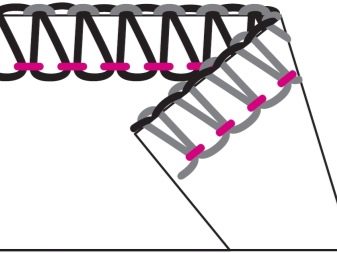

- Four-thread stitch... In addition to overcasting the edge of the product, using this type, you can sew pieces of material together, which is preferable when sewing knitwear. This element is quite durable, it is made with two needles and loopers, it is suitable for use on more elastic materials.
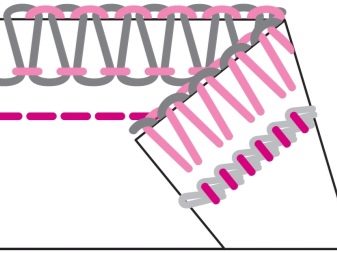

- Five-thread seam... A similar look is created on new devices using three needles. This stitch is more suitable for demanding fabrics, into which the following additional elements will then be sewn: fasteners, large buttons, brooches. Thanks to the five-thread stitching, the seam will be much more durable. It is usually used on light blouses made of crepe de Chine, organza, chiffon and other delicate and problematic fabrics.

- Single straight chain stitch. This type is used for sewing or hemming elastic fabrics. In carrying out this operation, two threads are involved: one of them is needle, and the second is the one that is fed using the chainstitch looper. The positive aspect of such a line is elasticity and the possibility of the most simple dissolution.

Overview of decorative varieties
Advanced equipment models allow you to perform more complex operations on them, for example, when making exclusive models using decorative types of stitches.
Role-playing
It can also be called roller, hemming or simply opikovka.... To achieve this stitching, the tensioner on the equipment must be adjusted. In the finished form, the finished edge of the product looks like an element twisted inward. In a similar way, you can depict a wavy frill. Installing a fishing line along the edge of the skirt makes the seam elastic. The petticoat, processed in this way, will allow you to get a more fluffy hem.

In addition to processing a cut of fabric, you can use a roll stitch to sew the ruffles of a costume designed for dancing. Also, this type is used when decorating elements of tulle and various items made from knitwear. You can create a rolled seam by shortening the stitch length to the minimum number or by changing the stitch width.
In all models of such equipment there is a special tongue, which is located at the stitch plate.... During work, it is in this position: on one side it is surrounded by an upper loop, and on the other - textiles. In this case, the edge of the material is not curled, but the line is sewn in the same width. In order to get a roller stitch, you must remove the tongue in advance. The end result will be a seam two millimeters wide with edges curled inward.

Flat
This type of seam is made on a special cover sewing machine, but in some models of overlockers there is a flatlock function, which provides for the execution of a flat seam.

This is the most commonly used option and can be performed on overlock equipment with some adjustment. To obtain such a seam, loosen the needle thread tension while pulling on the lower loopers. This way you can sew pieces of material that, when stitched together, form a flat seam on the spread. This type is more suitable for decorative finishing of curly elements of clothing, since it is not durable in sewing.
This type of seam can be two- and three-thread.


The two-thread version looks most attractive when processing the edges of thin fabrics. Flatlock is divided into narrow and wide seams. A narrow seam is made by threading the right needle in, and a wide seam with a left needle. To make a flat seam, you should choose thin lavsan threads, they should be absolutely smooth, elastic and not prone to breakage. Simple cotton threads are categorically not suitable for such work, as they can break and fray, as a result, the finished product will look ugly.

Bilateral
The formation of this seam with an upper overlap is possible on newer overlock models, which provide for the presence of a large number of threads. Thanks to the multi-thread weave, it is possible to get stitches that make beautiful patterns on the model... This double-sided version is used mainly not for processing a cut of a part, but for forming an ornament on garments.
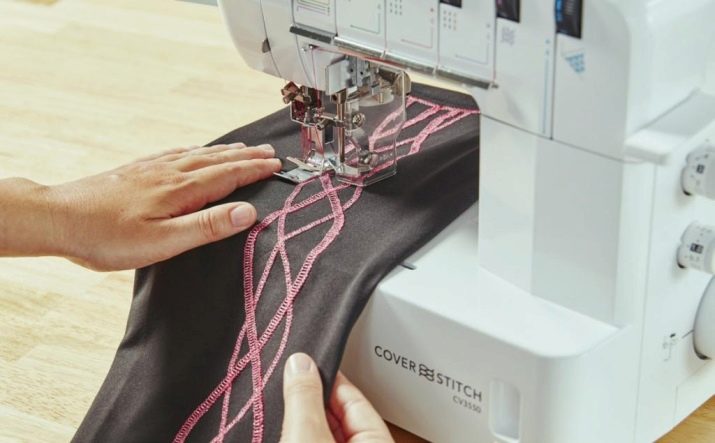
How do overlock seams differ from stitching? There are two main groups of stitches in sewing, but they all look like a zigzag stitch: the overlock stitch and the overlock stitch. Both seams are applied to the edge of the model to prevent flow and finish the bottom of the garment. They differ from each other in that the seam is performed on a specialized machine, and the stitch (false seam) is made on simple sewing equipment (this function is present even on inexpensive models). Edges processed not on an overlock, according to experienced craftsmen, are generally not considered overcasting.
If you remember that ordinary sewing machines are single-needle and with one shuttle, then any seam made on them will look like a zigzag of different shapes.



Overlock - specially designed to perform similar operations, will work differently. This equipment contains several loopers with installed needles instead of a hook. The needles, drawing a zigzag on the material, form a loop that captures the cut of the fabric. The lower working thread not only catches a part of the textile from the edge, but also grabs the upper thread, forming a loop in the process. With the help of such actions, the edges will not crumble, even if the stitch is close to the cut.


The nuances of choosing a seam
The overlock machine consists of such elements for carrying out operations, which make it possible to select the overlock stitch. With a set of special attachments, a cut-off width clamp, a special knife, a platform, such equipment compares favorably with a simple device in processing edges.
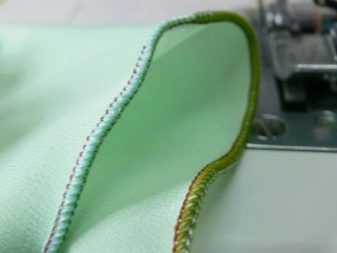

When choosing a specific overlock stitch, some nuances should be taken into account.
- If the overlock machine is purchased only for overcasting fabric cuts, then a model designed to work with two or three threads is quite suitable. In the case of future planning of sewing products with decorative types of stitches, you will need equipment with overlapping of four threads.
- The presence of the differential feed function allows processing elastic products and creating assembly elements and shuttlecocks.
- By adjusting the width of the cut taking into account the density of the material, it is permissible to create different variations in the performance of the same seam. The most beautiful stitch on the material, with a high density, will be obtained when the cutting distance for a roll-type seam is excessively increased; when working with light fabric, the distance should be reduced.
Sewing a variety of stitches on the overlock makes it possible to bring to life any of the most complex sewing ideas in order to achieve the desired result in the design solution. The main thing in this case is the availability of high-quality overlock equipment that meets all the requirements of a seamstress.
